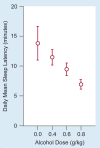Alcohol-Induced Sleepiness and Memory Function
- PMID: 31798081
- PMCID: PMC6875726
Alcohol-Induced Sleepiness and Memory Function
Abstract
Alcohol has sedative, as well as performance and memory-impairing effects. Several independent lines of research indicate that alcohol-induced sleepiness may contribute to the observed memory and performance impairment. Such a link would imply that alcohol consumption in combination with other drugs or conditions that enhance sleepiness could increase the risk for alcohol-related impairment.
Keywords: AOD impairment; AODE (alcohol and other drug effects); neurotransmitters; sedatives; sleep.
Figures



Similar articles
-
Driving impairment due to sleepiness is exacerbated by low alcohol intake.Occup Environ Med. 2003 Sep;60(9):689-92. doi: 10.1136/oem.60.9.689. Occup Environ Med. 2003. PMID: 12937193 Free PMC article. Clinical Trial.
-
Alcohol-Related Thiamine Deficiency: Impact on Cognitive and Memory Functioning.Alcohol Health Res World. 1995;19(2):113-121. Alcohol Health Res World. 1995. PMID: 31798071 Free PMC article.
-
Alcohol continues to affect sleepiness related driving impairment, when breath alcohol levels have fallen to near-zero.Hum Psychopharmacol. 2004 Aug;19(6):421-3. doi: 10.1002/hup.601. Hum Psychopharmacol. 2004. PMID: 15303246 Clinical Trial.
-
Sleep, sleepiness, and alcohol use.Alcohol Res Health. 2001;25(2):101-9. Alcohol Res Health. 2001. PMID: 11584549 Free PMC article. Review.
-
[Daytime sleepiness and driving behaviour].Ther Umsch. 2014 Nov;71(11):679-86. doi: 10.1024/0040-5930/a000610. Ther Umsch. 2014. PMID: 25377292 Review. German.
Cited by
-
Effects of age and alcoholism on sleep: a controlled study.J Stud Alcohol. 2001 May;62(3):335-43. doi: 10.15288/jsa.2001.62.335. J Stud Alcohol. 2001. PMID: 11414343 Free PMC article. Clinical Trial.
-
Sleep quality among clinical postgraduate students: a cross-sectional study in Kerala, India.BMC Public Health. 2025 Aug 12;25(1):2740. doi: 10.1186/s12889-025-23719-8. BMC Public Health. 2025. PMID: 40797241 Free PMC article.
-
Alcohol's effects on sleep in alcoholics.Alcohol Res Health. 2001;25(2):110-25. Alcohol Res Health. 2001. PMID: 11584550 Free PMC article. Review.
References
-
- Aldrich M. Narcolepsy. Neurology. 1992;42:34–43. - PubMed
-
- Birnbaum IM, Parker ES, editors. Alcohol and Human Memory. Hillsdale, NJ: Lawrence Earlbaum Associates; 1977.
-
- Carskadon MA, Dement WC, Mitler MM, Roth T, Westbrook PR, Keenan S. Guidelines for Multiple Sleep Latency Test (MSLT): A standard measure of sleepiness. Sleep. 1986;9:519–524. - PubMed
-
- Curran HV. Benzodiazepines, memory, and mood: A review. Psychopharmacology. 1991;105:1–8. - PubMed
-
- Dinges DF, Kribbs NB. Performing while sleepy: Effects of experimentally-induced sleepiness. In: Monk TH, editor. Sleep, Sleepiness and Performance. New York: John Wiley & Sons; 1991. pp. 97–128.
LinkOut - more resources
Full Text Sources
